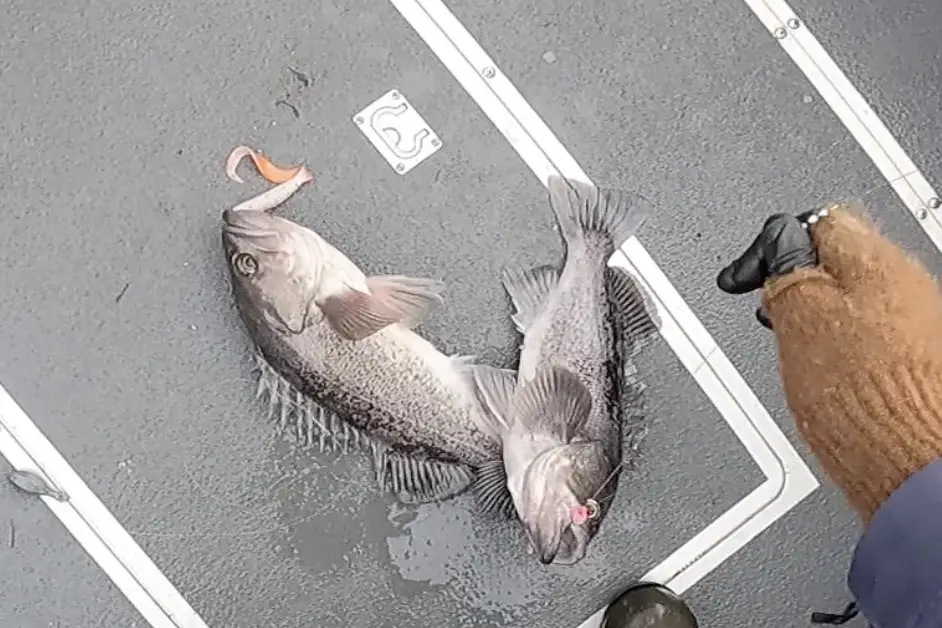
How to catch rockfish? Quickly, is of course the right answer!
Rockfish provide incredible angling opportunities throughout the ocean fishing season in the Pacific Northwest and they are incredibly fun and easy to catch.
I will heavily cover the topic of catching black rockfish or sea bass as they are colloquially known in the PNW, but these techniques will apply to all rockfish anywhere as I’ve not come across significant variations other than where populations of different species of rockfish are concentrated.
Okay, so why is the right answer quickly?
Well, at least in the PNW fisheries, there’s usually a higher target species on our agenda when we’re out on the water, and limiting out on rockfish, while great fun, is also one of those cool side-pursuits that make our time on the water fully worth it.
One can fill the freezer up for a year’s worth of white fish quite effectively if they can quickly limit on rockfish after or before chasing ling cod, salmon, or even halibut as the seasons intersect.
This page aims to help you with how to catch rockfish quickly.
How to find rockfish?
Rockfish are literally named for their tendency to spend time around…um rocks…So if you want to find rockfish…Ok, I will say it, you need to find the rocks!
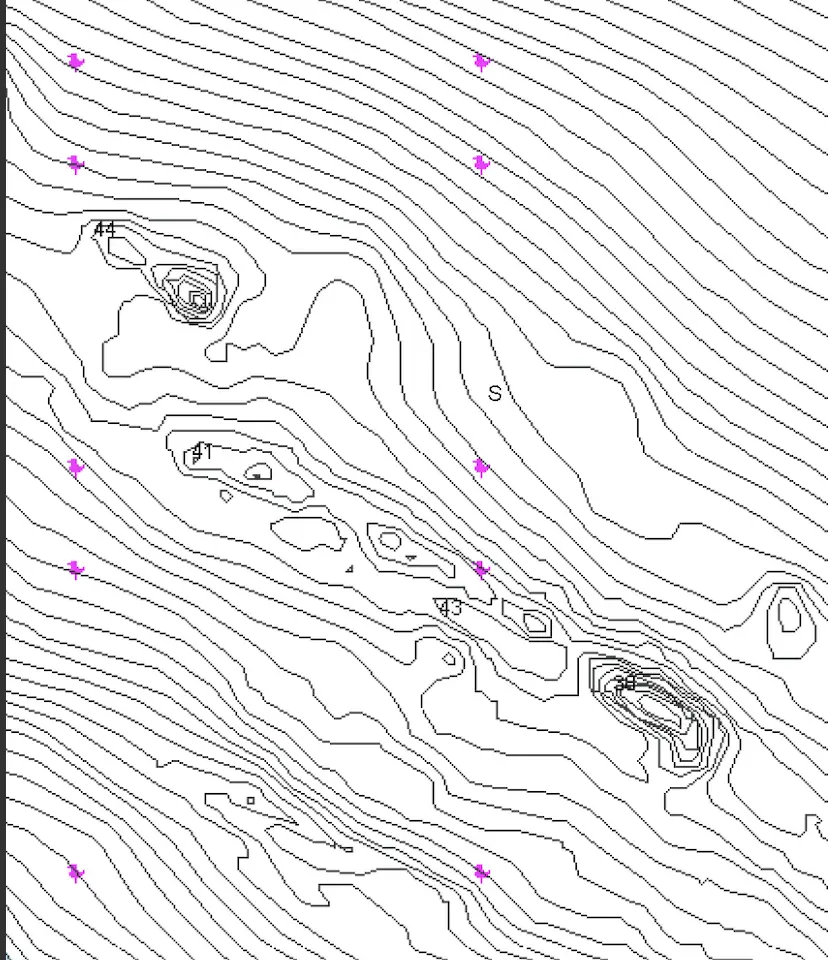
This can be as easy as studying marine charts before you head out or marking the GPS location of where you caught fish on that last charter you were out on…But don’t follow charters around, that’s not cool…
Or even it could mean looking for new rock piles on your sonar as you cruise around. The bottom line is that there’s no excuse to not find rock piles wherever you fish for rockfish as they are typically fairly common if you’re willing to do just a tiny bit of research.
What about specific locations?
I don’t want to do all your work for you here, but I will link to my pages on the 4 ocean marine areas off of the Washington Coast that get you going if you’re fishing in that area.
How to catch rockfish?
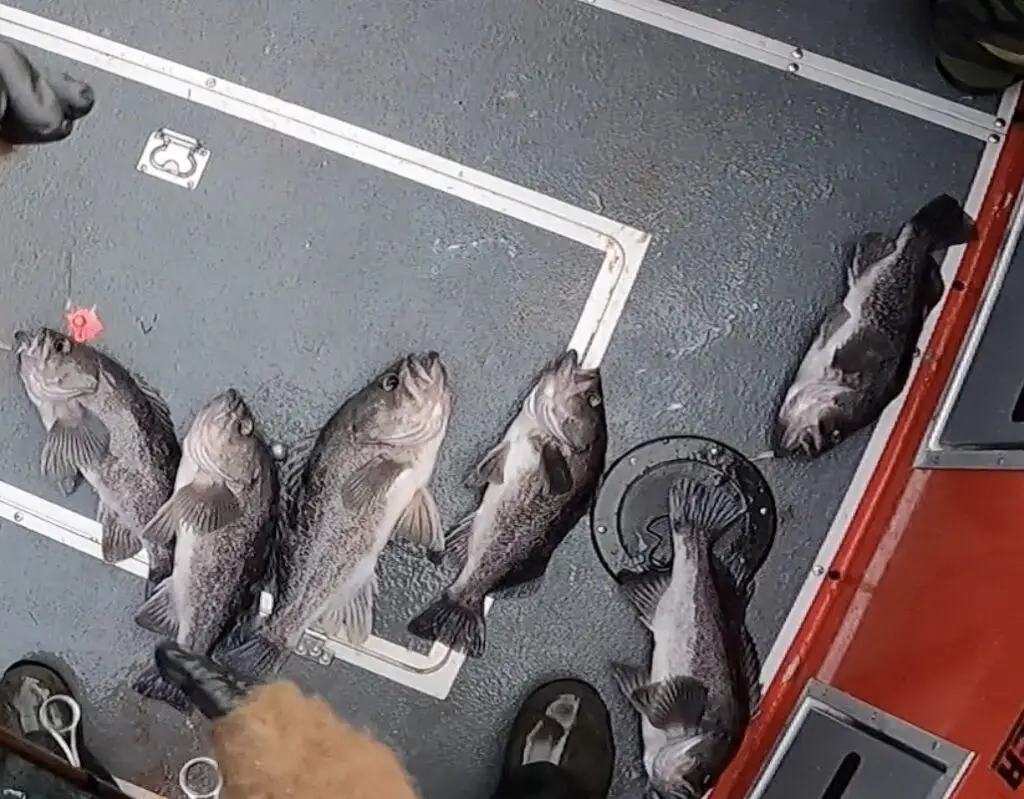
So you’ve found yourself a nice rock pile and you’re marking big schools of rockfish. Excellent! Now how do you catch these buggers? Quickly, is of course the correct answer again!
There are a number of factors that we will cover in detail here to get you squared away. One of the common misnomers and mistakes in regard to rockfish is to use jigs and to jig for them.
Why jigging for rockfish is NOT the best way to go…
I don’t care what kind of jig you’re using, if you’re jigging it, you’re fishing inefficiently and you will not catch rockfish…quickly.
I’ve captured underwater footage combined with enough experience on the water to confidently conclude that the entire jigging motion is unnecessary.
Every time you make a sharp pull with the rod tip you’re pulling it away from an interested rockfish.
Rockfish tend to hang out in very large hungry schools that don’t need much convincing to bite your offering. They certainly don’t need your jigging motion which makes it harder for them to track down their prey.
So, what’s my problem with jigs? They have weighted hooks on them…What’s wrong with that? Well, if you have a weight that’s gonna hit bottom with a hook on it, you’re gonna stick it in the rocks…you know the place where rockfish hang out?
Seriously, how much lead do you want to donate to the ocean?
Do this instead: Use lead only as a dropper weight and tie your hooks to leaders suspended above the hook at least 12-18 inches.
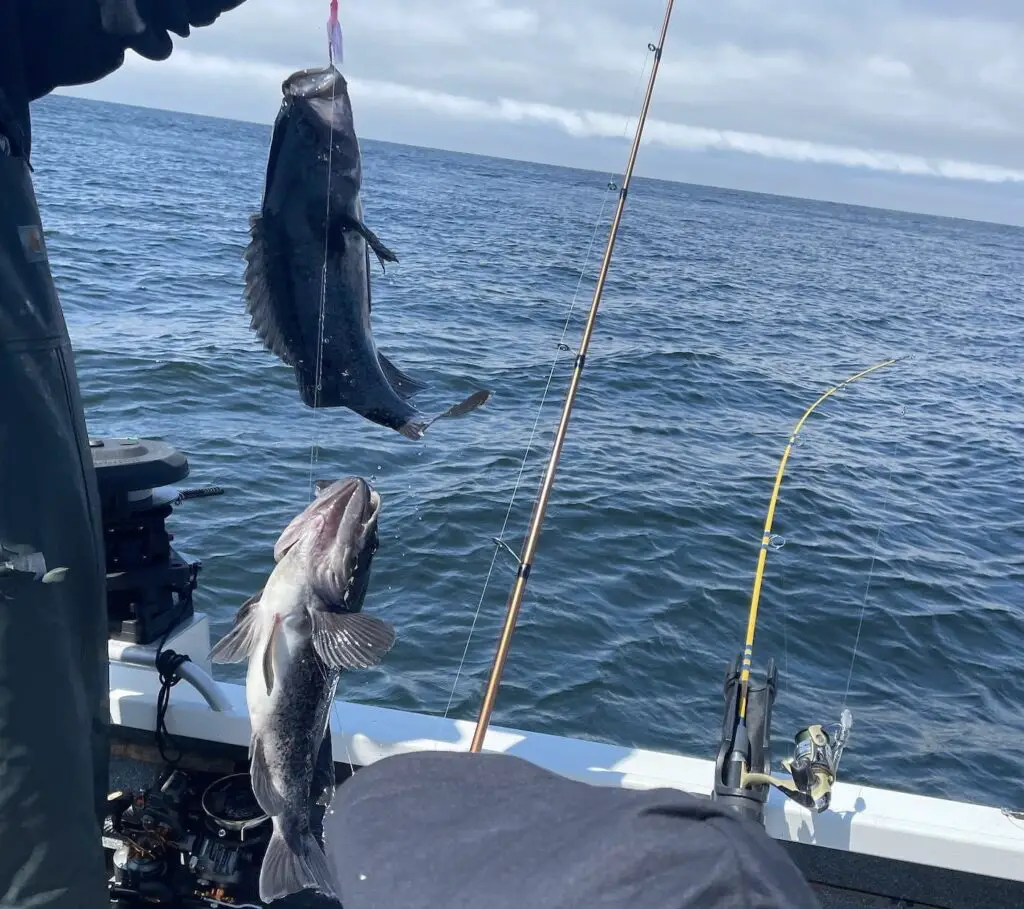
I like to tie a double rig that puts a plastic grub on the bottom hook and a shrimp fly on the top leader separated by about 18-24 inches.
While I have my own YT channel, I like to embed other videos at times that I think will be helpful to you all, and this one from Salt Strong was very helpful on how to tie up this favorite rig.
Yes, this is for beach fishing, but this is my new favorite approach to catching rockfish.
Tie the above rig according to the video exactly. Use the appropriate cannonball size for the water you’re fishing.
I find 3 oz to be the best all-around size. I use 40-60 lb mono as my core leader and 15-20 lb leaders for the hooks and dropper weights.
Tie extra droppers and hooks up so you can quickly swap them out if they break off.
I describe the rig and fishing it quite a bit in the above video from 2022 as well.
You drop this double rig down until you hit bottom and then come up a few cranks and you literally just hold it steady.
When that first rockfish hits, you just hang with it…don’t reel or go crazy with a hook-set, just wait a few seconds and that second rockfish will be on quite shortly.
When your rod really loads up, crank it to the surface and you’ve got a nice rockfish double.
Don’t bother netting these rockfish and getting your crap all tangled, grab the mainline like a boss and toss em in the boat and get back down to catch another two rockfish!
Rockfish identification is critical
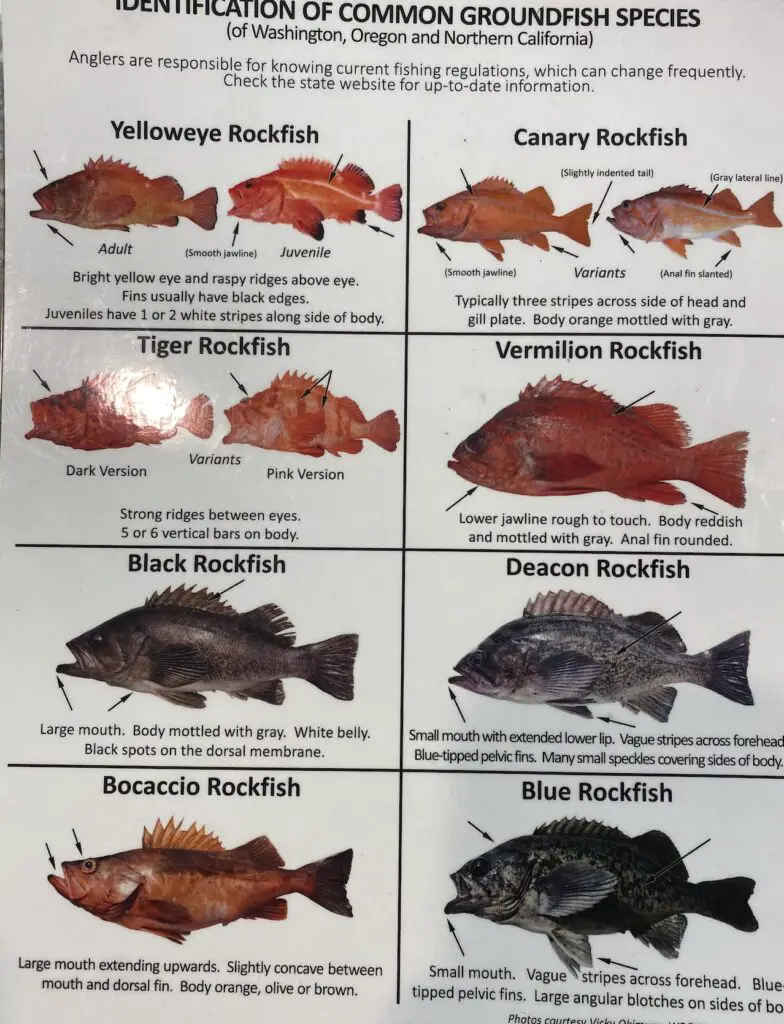
One of the things I should mention here is that knowing how to identify rockfish is supercritical.
Your local regulations usually define which species can be caught where which can help you avoid harvesting rockfish populations that aren’t healthy and avoid a big fine if you get caught with the wrong type onboard.
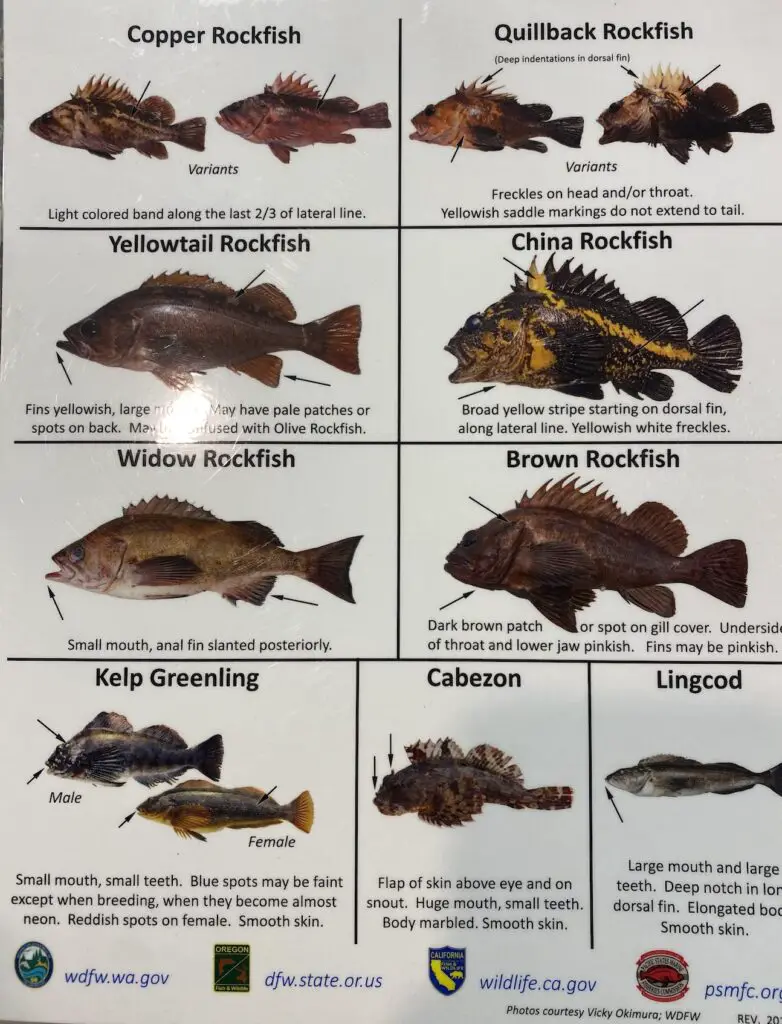
Find a laminated copy of these pages for the identifying rockfish in the PNW, or print out these photos, laminate them at your local print shop and keep them on your boat.
How best to work your boat for catching rockfish?
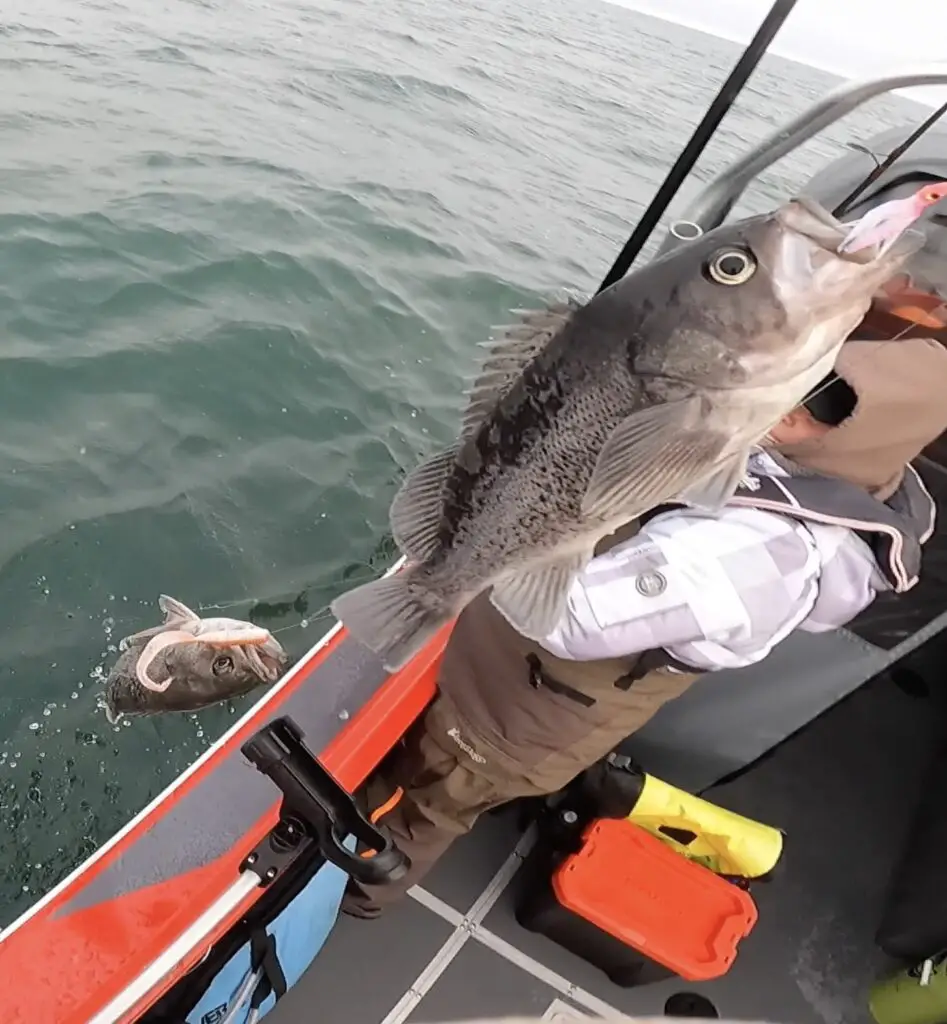
Now there are a few boating strategies you need to employ to really make this effective and even better if you work in conjunction with your electronics to be super efficient about things.
First of all, you need to mark schools of rockfish on your sonar…second, you need to know 100% which way the current and wind are taking you…keep in mind on a big rocky reef in shallower water the currents could be quite dynamic, but you need to be able to accurately figure out where to start your drift in a way that takes you right into the heart of that rockfish school.
Second, as you’re drifting, you need to work the kicker motor directionally and in terms of reverse / neutral to try to maintain the ideal drift direction while also slowing things down.
If you’re drifting faster than 1 knot, you’re gonna have problems. I like to be around .4-.7 knots personally…I want to cover water, but I don’t want to scream by either.
Now, as you’re drifting through the school, you need to know where they are in the water column.
Yes, they will often be near the bottom, but they will also often be right in the middle too. I don’t fish with line counter reels (I started to use line counters in 2023!) on my rockfish setups (which I will cover shortly), so I like to drop to the bottom, come up a few cranks, and then reel slowly through the school as I see them on the sonar screen.
Once you reach the correct depth, you will get bit by rockfish.
Again, don’t worry about jigging it, the current, boat speed, etc all provide more than enough action on your plastics and shrimp flies to get bit by your target rockfish school.
One of the things you need to keep in mind with this strategy is whether you are fishing uphill or downhill.
If you’ve got your kids on the boat or some newbie anglers, and you’re drifting uphill, as the depth is getting shallower as you drift into the rock pile/reef, you’re gonna lose a ton of gear even with dropper lead.
The best uphill strategy is to either don’t drop all the way to the bottom (stop about halfway), or if the angler is experienced, hit bottom and immediately come up and reel slowly and constantly as the boat drifts uphill.
It takes new anglers several seconds longer to realize they’ve hit bottom than experienced anglers, and those few seconds will be just enough to get hung up on the rocks when drifting uphill.
I will tell some to just hold off until I see the rock pile crest and then have them drop immediately so they get the benefit of downhill drifting.
Best terminal offerings, lures and bait to catch rockfish with
How do we rig up to catch rockfish?
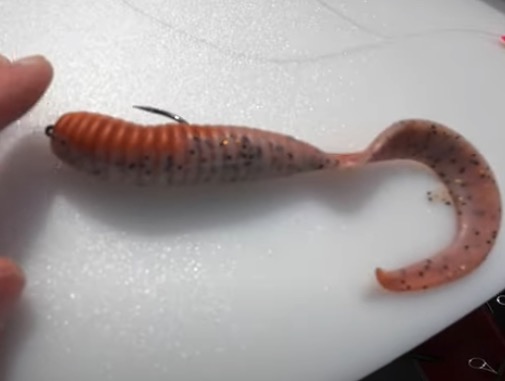
There are so many lures and terminal offerings that work with rockfish, but I prefer to use the Berkeley gulp plastic grubs on my lower part of the double rig.
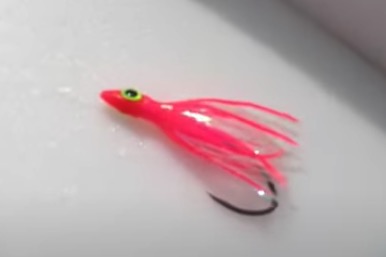
I use an Ace High Fly Jr. as my shrimp fly on the top part of my double rig. I use the same Ace High Fly Jr’s for salmon, so I don’t need to buy anything different and I love it when I can multi-purpose any gear.
Best gear setups to catch rockfish with
In terms of rod/reel/mainline setups, there are many options here as well that work, and I cobble together enough rod/reel combos from my stock of gear to get 4 to 5 people fishing.
However, I can tell you which combination is my absolute favorite.
I use a cheap but quality one-piece 7′ casting rod with medium power.
I paired it with a decent line counter levelwind reel. I love the advantage of a line counter that allows you to target rockfish that are mid-depth not just right on the bottom. I use this same setup to jig for salmon in the summer and squid in the winter!
And spool it with as much 20 lb braid as I can fit.
This setup just gives me great joy to fish, it’s light and very sensitive to feel everything and you can reel a pretty big fish on this if you end up connecting with a lingcod while fishing for rockfish (which is not uncommon at all!).
I landed a 35 lb halibut on this setup while fishing for rockfish so…it can absolutely handle some weight, but it’s massively fun to catch rockfish with.
Descending device is a MUST have
Okay, let’s cover a few other important topics on catching rockfish while we are here. You need to have a descending device rigged up and ready to go.
They make a variety of descending devices that you can attach to your downrigger or to a spare fishing rod.
After doing both, I will say the spare fishing rod is the way to go…I had the more elaborate and expensive downrigger option, but after losing a downrigger ball during the release process, I’m kind of over that.

It’s a big lead weight with a cheap descending device like the one above, on a spare rod for me.
Also, if you think you can get away with just whacking them with a gaff until they decide to go down…First of all, it’s illegal to fish for bottom fish in Washington (and maybe other places?) without a descending device ready to go on your boat, second of all, you can waste a lot of time trying to coax a rockfish back down without a descending device.
If you’re like me and you don’t like to waste a resource like a rockfish and that floater will bother you, you’re gonna waste a ton of time poking at it with the gaff vs just using the descending device to get that rockfish back down to the depths and move on with your life.
How do you catch rockfish from the Bank or Jetty?
Quickly…Okay, I will stop.
Because this might not be nearly as quick. And if you’re fishing from a jetty or rocky shoreline, these rockfish might even be your primary quarry, which can be an absolute blast without the hassle and expense of a boat.
Fishing from the bank for rockfish does require resetting your expectations though. You also will want to be picky about your conditions. Huge surf or heavy currents are not your friends here.
Oftentimes, the jetties near major river mouths and ports are the ideal places to target rockfish. You need to be really mindful of a few hazards here though.
The marine weather is the big one. You want smaller swells, less wind, and smaller tidal currents to help you hone in on your rockfish.
However, the second one, not to be ignored, is the often treacherous condition of the jetty itself. I’ve literally broken my leg (microfracture) slipping and falling on a jetty rock. Some parts of the jetty are incredibly slippery.
There are also holes you can fall into. And retrieving your catch could be an adventure if you don’t have an easy way to climb down the jetty rocks to get near the water’s edge.
But let’s assume you’ve taken all this into account and are still eager to get out and catch rockfish from the jetty.
You basically have two approaches that can be successful: 1. Float fishing and 2. Bottom fishing.
If you’re float fishing, you will really need low currents, but you can get away with lighter tackle which really increases the fun factor of catching these fish. Simply rig up a slip float system just like you would for salmon and set up your stopper at the right depth.
For bottom fishing, we like to use a dropper line with a reef rock of the right size shape that you can tie whatever knot is good enough to get you through a cast without losing the rock.
This is because using anything else will really get expensive quite quickly since there’s no “coming up off the bottom”.
You are casting it out there, letting it find the bottom, waiting until a fish bites, and potentially breaking off your dropper as your weight/rock will often be hung up, which is okay since you didn’t pay for the rock, right? Right.
Now, what bait should you use? There are many that work, but live sand shrimp will probably outfish most everything else.
You can use a sand shrimp pump/gun and find these buggers on a number of beaches on even modest low tides.
If you’ve ever been razor clamming and arrived too early, all those shows higher up the beach are sand shrimp, and they are incredibly easy to catch.
You can even go razor clamming in the morning (in the springtime), grab your sand shrimp, and then spend the afternoon on the jetty targeting rockfish.
How to process your rockfish
The bottom line is that if you follow even half of the advice on this page, you’re gonna catch rockfish like crazy, but now you have another problem…
What to do with them?
Rockfish meat is very tasty, especially fresh. But even later on it’s an incredibly mild and firm white meat that can be used in everything from fish tacos, fried fish n chips, or fish bakes.
But getting the meat off of the incredibly tough bones and getting past their often very armored exterior can be a challenge.
I’ve explored a variety of knife options, and I’ve landed on what has quickly become my all-time favorite fillet knife for rockfish.

Black Titanium Nitride Coated – High Carbon 7CR17MOV-X Vacuum Treated Steel – Meat, Boning Knife – Sheath – NSF Certified
WARNING: You will fall in love with this knife and I apologize already to your friends and family as you will feel compelled to show it to them…
What makes this such a great fillet knife for rockfish? Well for starters, unlike filleting a big king salmon, you want a shorter blade that is very stiff for rockfish.
Additionally, this blade is the sharpest I’ve ever owned.
I have processed an entire deer with it, and a bunch of rockfish and lingcod during an ocean fishing season…and it was still the sharpest knife I owned after sharpening all the other knives.
It’s that awesome!
You should be aware that many rockfish species have poison in their quills on their back, so you need to be super careful handling them during the filleting process. They can jack you up!